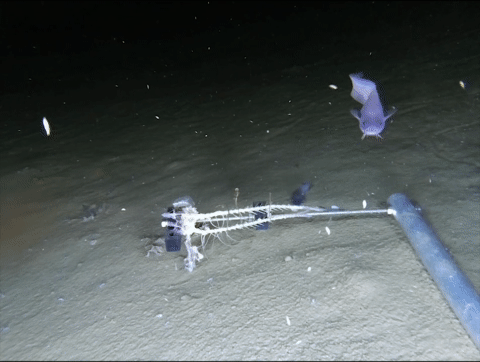
New, blue fish found in deep-sea trench
Snailfish live at the deepest parts of the ocean. Now an expedition has found a new species; it is small, blue and looks anything but a deep-sea monster.
Deep-sea trenches make up the deepest parts of the world's oceans. Here, depths go beyond 6,000 meters, and until recently, it was generally thought that no life could thrive here. That is why the ocean area below 6,000 meters got named the hadal zone after the ancient Greeks' kingdom of the dead, Hades.
But recent research, carried out on deep-sea expeditions led by the Danish Center for Hadal Research at SDU, has shown that there is an abundance of life to be found in the hadal zone, from bacteria and viruses to sea cucumbers, crustaceans and fish. And now participants on a recent expedition to the Atacama Trench report the discovery of a completelynew species of fish.

Deep sea trenches are isolated environments
The new species is a snailfish (Liparidae), and it does not in any way live up to the stereotype of solitary hunting, murderous deep-sea monsters; on the contrary, it is small and social, and almost cute to look at.
So far, researchers have described 15 different species of hadal snailfish. Each species tends only to be found in a single deep-sea trench, but up to three species have been seen in the same trench.
Common to all species is that they can be traced back to a single, common ancestor. This means that descendants of this common ancestor have found a deep-sea trench several times and colonized it.
Because the deep-sea trenches are so isolated from the world around them, these fish populations also became isolated, and over time, they have evolved into their own species.
Baiting at 6-7000 metres
Now an international research team has described in a scientific journal a snailfish that not at all look like other deep sea snailfish.
It was found in 2018 on an expedition to the Atacama Trench, which runs along the west coast of South America. The expedition was led by Professor Ronnie N. Glud from the Danish Center for Hadal Research and is part of a series of expeditions to investigate the biogeochemical and biological processes taking place in the world's deep-sea trenches.
The research team, consisting of Alan J. Jamieson of the University of Western Australia and Thomas D. Lenley of Newcastle University et al., dropped their film and sensor equipment over the ship’s side and let it fall to the bottom of the trench. They also attached bait to it to attract the animals that might live there. Three different snailfish showed interest in the bait - and of these, one stood out.
There are probably more undiscovered animals in the deep sea
It was small and blue with large eyes and colors that are otherwise only seen in snailfish that live higher up in the water column. In their scientific article, the researchers conclude that the new snailfish belongs to the genus Paraliparis, which belongs to the family of snailfish.
Fish from this genus are found all over the world, but there are a lot of species in the southern Atlantic near Antarctica. They are rarely seen in waters deeper than 2,000 meters - and certainly not at the 6-7,000 metres depth at which the new species was spotted in the Atacama Trench.
The new species has been named Paraliparis selti, which in the Kunza language of the indigenous population of the Atacama Desert means blue.
According to the researchers, the new species may have evolved from the part of the family that adapted to life in the cold South Atlantic. In any case, the research team points out, the finding shows that there may still be animal species in the deep waiting to be discovered.
Deep-sea research at SDU
SDU is the base of Danish Center for Hadal Research, whose researchers are currently leading or participating in expeditions to deep-sea trenches all over the world. In 2022 to The Aleutian Trench, Japan Trench, South Sandwich Trench and 11 trenches in the North Pacific.